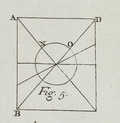
A Treatise on Painting, by Leonardo da Vinci
1721
Senex and Taylor, London
Illustrations:   | Chapter Display  |
I338I341
A White Object, being placed between two Walls, the one whereof is Black, and the other White; the same proportion will be found between the enlighten'd and the shadowed parts of that Object, which the two Walls are seen to bear to each other; and if the Object were of an Azure Colour, the effect wou'd be the same: so that if you shou'd have occasion to Paint such an Object, take the following Method; to give the Object which is here supposed to be Azure, its proper Shadows, take a Black, like the Blackness of the Shadow, supposed to be reflected from the Wall upon the Object; and to proceed on the surer Principles, observe what I am now about to deliver. Of what Colour soever the Walls are to be Painted, take a little Spoon, larger or smaller, as the occasion may require, having its Brim of an equal Height all around; and with this, measure very exactly, the several simple Colours, necessary to form your Compounds: Thus for instance, if you have given the principal Shadows of the Wall, three Degrees of obscurity, and one of brightness, that is three Spoons full of Black, mingled with one of White; your mixture will be fix'd, and determined. After having then made one Wall Black, and another White, and have an Azure Object, to place between them, which you wou'd bestow the Lights and Shadows, proper to that Azure; place on one side, the Azure Colour which is to remain clear, and without any Shadow, and the Black by it; then take three Spoons full of Black, and mix them with one Spoon full of bright Azure, which mixture must serve for your deepest Shadow: This done, consider the Form of your Object, whether it be Spherical, Cylindrical, Square, or otherwise; if it prove Spherical, draw Lines from the extremes of the dark Wall, to the Centre of the said Sphere, and between the Points where these Lines cut the Surface, dispose your deepest Shadow; after this, observe to illumine or alleviate your Shadows by little and little, in proportion as you remove from the Extreme of the strongest Shadow; as for Example, in N O; [Tab. 2. Fig. 5.] still weakening the Shadow in that place, in proportion as it participates of the Light of the upper Wall A D: and this Colour, you must join to the extremity of the principal Shadow of the second Line A B, in the same manner, and with the same regulations already laid down for the first.